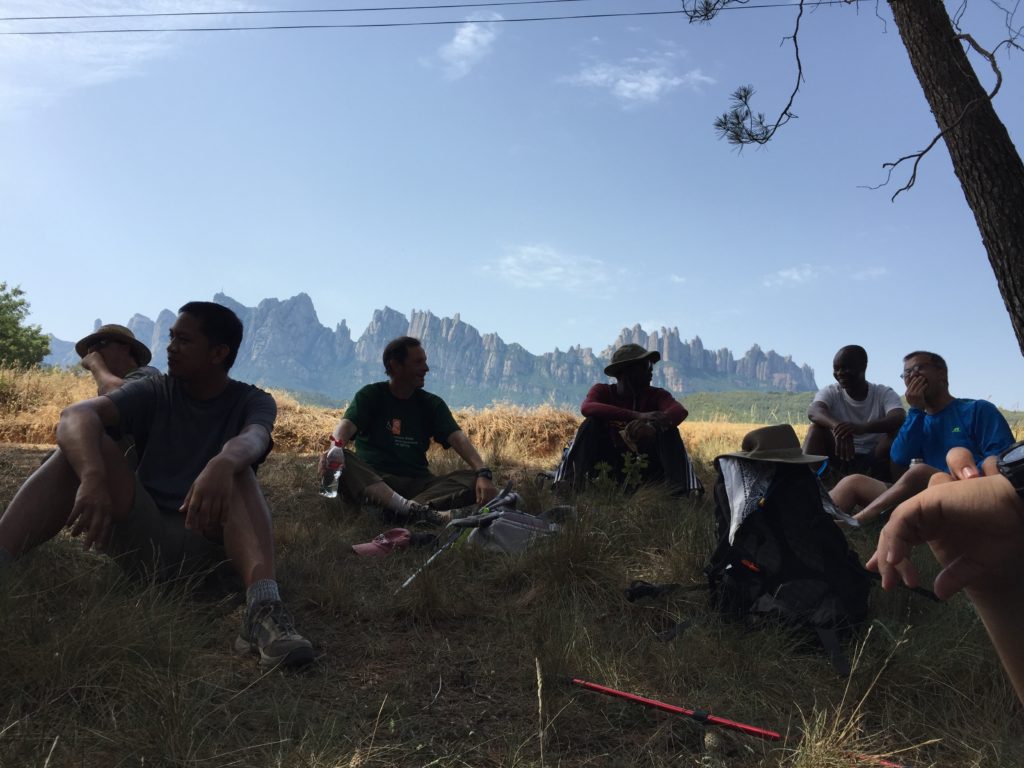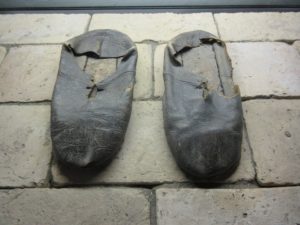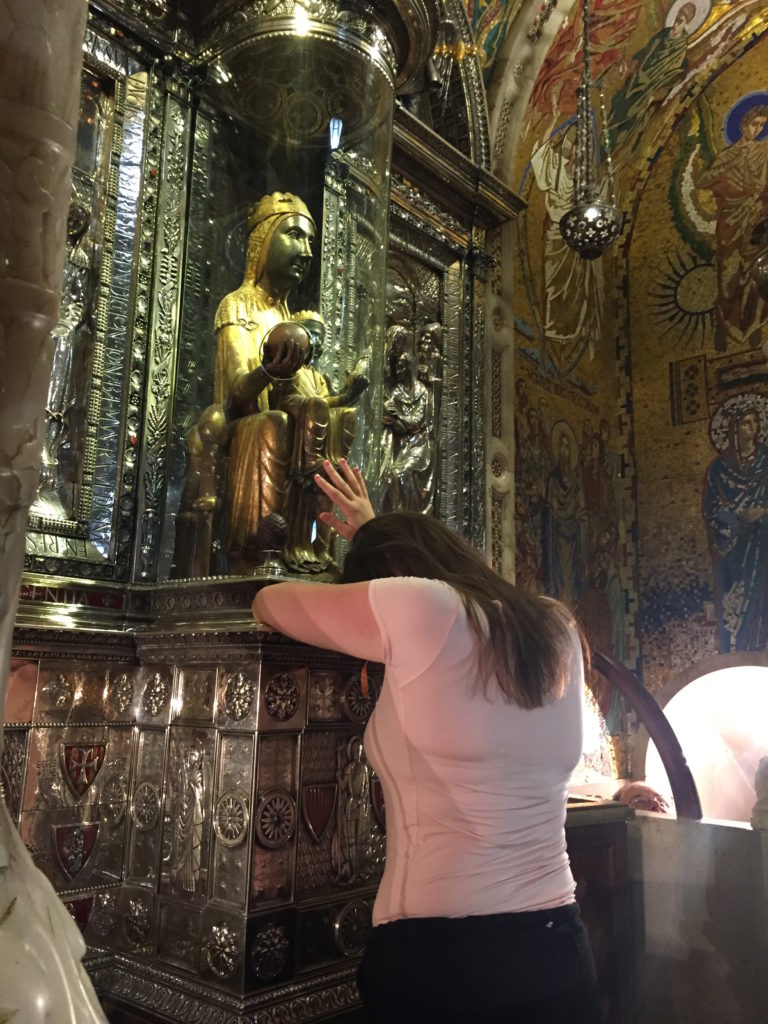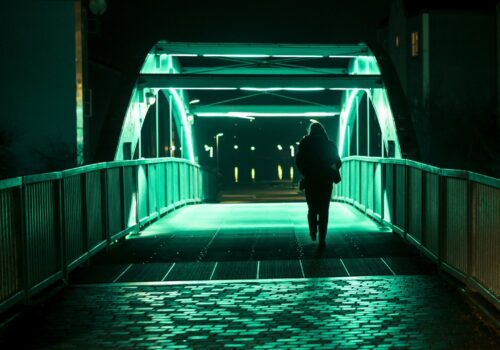MONTSERRAT, Fourth of July, 2015

Photo: Hung Pham
Professor Barush:
With blistered feet and clothes that never got quite clean enough in the albergue bathroom sinks, we were settling into our life as pilgrims by the time we left the Saint James Pilgrim Hostel in Jorba. We had met a pilgrim from Belgium there, walking the Camino de Santiago (which intersects at several points with the Camino Ignaciano). After we broke bread, he told us, “ultreia et suseia!” – the lyrics of an old pilgrim chant in archaic words that are said to translate to, roughly, “onwards and upwards.” With his prophetic send-off, we crawled into our bunks and rested before the long journey ahead.
It was early dawn when we hoisted our backpacks onto our shoulders and began the long, hot trek to visit the ancient mountain shrine of Our Lady of Montserrat, nestled in the Catalonian mountains. When we arrived at the bottom of the mountain, the sun was racing to the center of the sky and our shadows were becoming shorter. Humming and breathing and listening to the footfalls and rhythmic taps of hiking poles, we began the ascent with determination and anticipation. Prof. Barush encountered and jotted down a powerful experience.
My toenail had slowly been turning a gothic shade of dark plum due to the minor “trauma” of pushing against my boot, so I had put on some practical German sandals which were much more comfortable but sloped on the sides and so kept trapping little stones. As I walked in silence, I shook them out thinking of the song By My Side, from the 1970’s musical Godspell, that my friend Marie had sung at mine and my husband’s wedding many years ago:
Let me skip the road with you
I can dare myself
I can dare myself
I’ll put a pebble in my shoe
And watch me walk (watch me walk)
I can walk and walk!
(I can walk!)[15]
Here I was, skipping the road but far away from my husband and the baby daughter who is one of the most amazing fruits of our loving union. But, like the pebble in my shoe, there were burdens and shortcomings that I was reflecting on as we trudged slowly up the winding, dusty mountain pass. One of them was pregnancy loss and the healing that came with the electric heat and sweat of walking 250 miles; I was starting to trust my body again (I can walk!). There were other things, too: choices, anxieties, losses…but, as we approached the shrine, none seemed insurmountable (I can walk and walk!)
Looking down the mountainside was dizzying but spectacular. I noted the huge Benedictine monastery where I would later visit the nuns who create saints and sculptures from clay. At that moment, their swimming pool looked like a mirage of some tropical watering hole as I rubbed dust out of my eye. The tour busses zipping up the mountain past us in clouds of diesel seemed as though they were from another universe; women in billowing silk scarves and men with sunglasses and panama hats shouted friendly greetings out the window and others pointed their cameras at our sunburned and dusty cavalcade. Zooming past, they disappeared around the tight bends (watch me walk, watch me walk).
We knew we were getting closer when the air became cooler. Little mosaic stations depicting Madonnas the world over (Our Lady of Fatima, Our Lady of Guadalupe) decorated the high mountain walls as we yawned to un-pop our ears in the altitude. When we finally arrived at the town, we found ourselves in a sea of tourists in shorts and linen with ice cream cones and cameras. It seemed as though there was a constant flow of foot traffic in and out of the souvenir and clothing shops as we rested on some dusty stairs quite aware of how smelly we were after the long climb. One of the students stopped in the medical bureau to get a strange rash evaluated and another looked at me and asked, plaintively and profoundly, “Where’s Mary?”
The injured student emerged from the clinic (she was ok) and we all rallied for one more push—this time to the monastic housing where we would stay for the night. As we approached the outskirts of the shrine, we saw the long queue to see the Black Madonna. In the courtyard of the basilica, a group of men and women practicing a form of earth-based spirituality stood at four compass points facing the hot afternoon sun. Their ritual was a reminder that the mountain was much more ancient than the Bible, and that the ground and nature pulses with an energy of its own. It was Mary who called to the Camino Ignaciano pilgrims from inside the mountain, however, and we got in line to pay her a visit—just as Ignatius had several hundred years prior.
The enthroned statue of Mary, holding a great, golden orb with Christ seated on her lap, is attached to many legends and oral histories. Some say that the statue was carved by St Luke during biblical times and then carried to Spain by one of the apostles. During a Saracen invasion in 718, the statue was said to have been hidden from the enemy in a cave. [16] It was later discovered by shepherds who had been led to the hiding place upon following mysterious lights and heavenly song. A later Bishop wanted to move the statue to Manresa, but it miraculously became heavier and heavier—Mary apparently wanted pilgrims to come to her in the mountain of Montserrat. The shrine has since been the site of many miracles and attracts over a million pilgrims a year.[17]

St. Ignatius of Loyola was one of those who found solace at the shrine of the Madonna of Montserrat. It was there that he surrendered his sword and took up the symbolic garments and life of a pilgrim, following the path of Christ. In their discussion of pilgrimage as a liminoid phenomenon (e.g. voluntary, non-routine), Victor and Edith Turner point to the transformative effect of approaching the final grotto or shrine, where sins are forgiven and the pilgrim identifies with “the symbolic representation of the founder’s experiences”—hence “’put[ting] on Christ Jesus’ as a paradigmatic mask.”[18] Even though Montserrat was one stop—or perhaps, “station”—along the way to Jerusalem (here I am thinking of the Via Crucis, with its many sacred centers where the pilgrim pauses to pray), it was here where Ignatius symbolically (and literally) cast off his knightly attire and sword, and clothed himself as a pilgrim in sackcloth with a gourd to drink from. When he arrived at Montserrat he kept vigil all night and decided to “clothe himself in the armour of Christ.”[19] While at Montserrat, functioning in this context as a both a destination and point of departure, Ignatius made a written confession for three days—compatible with the Turners’ notion of the transformative effect of reconciliation during this phase of pilgrimage.
The experience of the students reflects, but also, crucially, continues what Ignatius had experienced in the sacred mountain. For example, one of the students shared that “at Montserrat, [a] sense of identification with Ignatius deepened” and another affirmed that “as [he] walked in places like Loyola, Montserrat and Manresa, [he] was permeated by the spirit of the Saint in a more radical way.”[20] The student who had wondered aloud where Mary was among the throngs of people had a moment of peace and consolation at the shrine where she was able to leave behind burdens of her own:
In little moments, when I paid attention to the grace around me instead of the pain of my feet and exhaustion, it was evident how the Spirit was at work. The interior work along with the great consolation at Montserrat, brought me inner peace. I became in tune with my deepest desires and was graced with interior freedom. I was reminded through this transformation, that the Christian vocation is about love. I am grateful for the grace of freedom that will enable me to love more deeply and healthily, beginning with myself.[21]

While this experience was one that emerged from her own personal pilgrimage, struggles, and contemplations, it was the act of following Ignatius’s route that acted as a stimulus for this shift. She recalled, “As [Ignatius’] conversion story unfolded before us, it drew me inward to the spiritual dynamics at play in my own story.”[22]
Likewise, another student (a Jesuit scholastic) shared a moment of letting go of unhelpful burdens keeping him from becoming a good priest and Christian. His description is framed within the autobiography of Ignatius, even though the experience is entirely his own: “The moment in which Ignatius placed his armor and sword before Our Lady of Montserrat…illustrates the power and beauty of conversion and turning one’s life around.”[23] The student goes on to describe a significant vision in which Mary helps facilitate a leaving behind of burdens; together, they stamped out the unhelpful “negative messages that led … to darkness and isolation.”[24] The theme of reflecting on letting go of negativity appeared in many of the students’ narratives post-Camino. Another shared:
As the scene unfolded, I wasn’t before a statue of Mary. Instead, I was experiencing the real presence of Mary alive and well in my prayer… I’ve found myself reflecting about what Ignatius had left behind, and I began to similarly ask myself if there is anything that I need to leave behind as I look ahead into the future.[25]
Again, the experience that Ignatius had and the imaginative putting-on of the “paradigmatic mask” of the saint helped to facilitate a powerful, and very personal, moment that revealed the things that were blocking the students in their lives and in their relationship with God.
There is a lightness that comes with letting go of our swords and carving out a new path. We learn that we can walk and walk.
I shall call the pebble Dare
We will talk, we will talk together
We will talk about walking
Dare shall be carried
And when we both have had enough
I will take him from my shoe, singing:
“Meet your new road!”[26]





